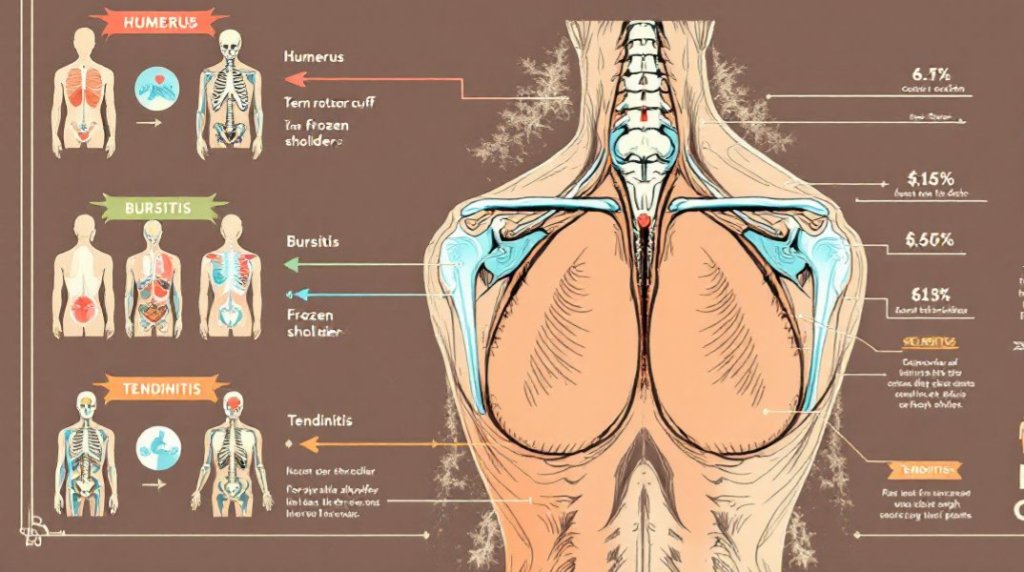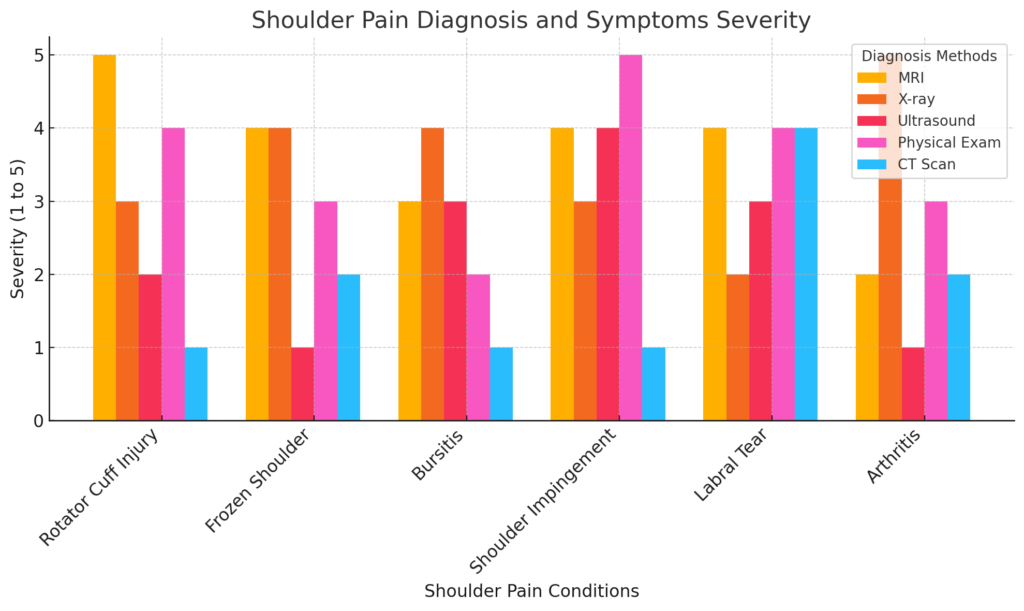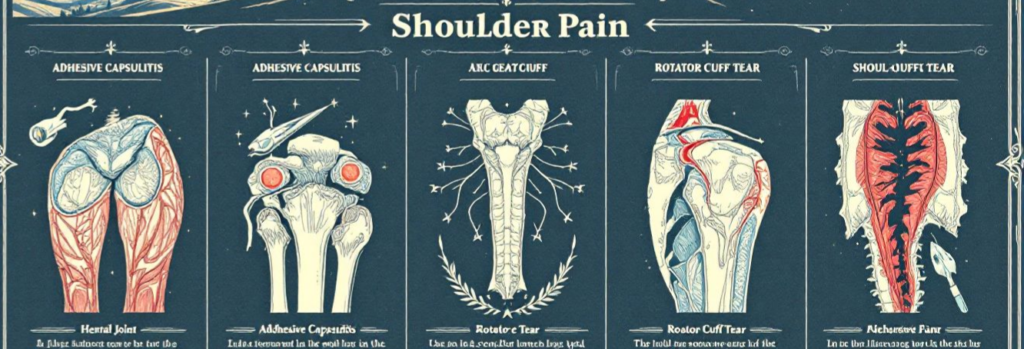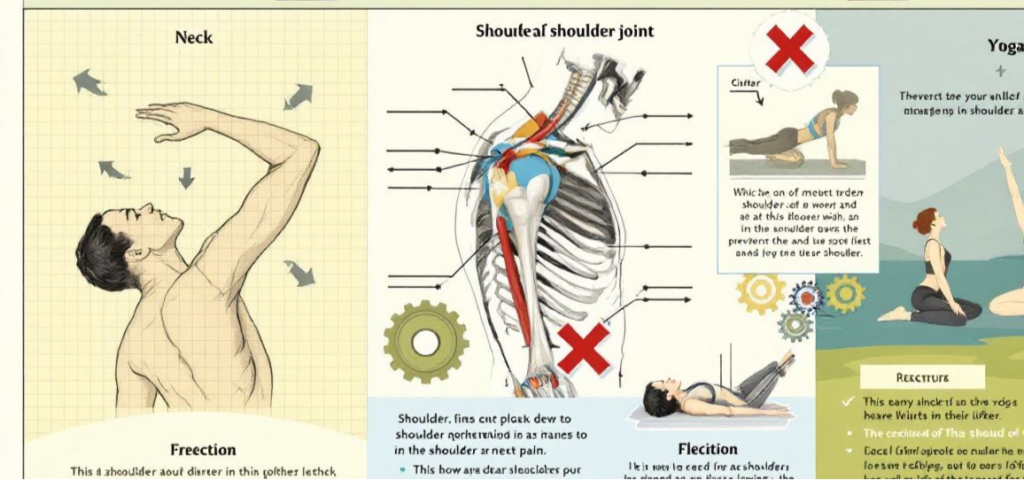Shoulder pain diagnosis chart is not just a piece of paper but a detailed guide to help identify the source of the pain and the underlying cause.
By the way, did you know that approximately 18% of the population experience shoulder pain at some point? That’s a big number!
That’s why we will show you how to use these charts, identify each and every pain part and symptoms, and diagnose potential shoulder problems.
Shoulder Pain Diagnosis Chart
Shoulder pain diagnosis charts are for you and your doctor. They help you match the location of your pain with the problem. By knowing the location of your pain, you can get the right treatment fast.
These charts categorize symptoms to help you know when to go see a doctor. They usually have two sections: front shoulder pain and back shoulder pain.
This makes it easier for you to know where your pain is, whether it’s around your shoulder blades, joints, or the shoulder itself.
How to Use Our Shoulder Pain Diagnosis Chart
A shoulder pain diagnosis chart may look a bit weird at first, but it’s really simple. The charts show the relationship between pain locations and shoulder conditions.
For example, pain in the front or side of your shoulder could be related to rotator cuff injuries or shoulder impingement syndrome.
Here’s how to use these charts:
- Find the area of pain on the shoulder diagram.
- What type of pain is it (sharp, dull, constant, or intermittent)?
- What makes it better or worse?
- Match your symptoms to the chart.
This visual will be a huge help when explaining your symptoms to medical professionals.
Types of Shoulder Pain Diagnosis Charts
Shoulder pain diagnosis charts come in different forms, each serving a purpose. They help you get to the root of your shoulder pain by categorizing it by anatomical regions or symptoms. Here’s a quick summary:
- Location-Based Charts: These categorize pain by specific areas of the shoulder front, side, or back. These are useful if you’re trying to figure out issues in the rotator cuff or shoulder socket.
- Symptom-Based Charts: These focus on the symptoms you’re experiencing, like shoulder bursitis or shoulder impingement syndrome. By knowing your symptoms, you can better figure out what’s going on with your shoulder.
Using both types of charts will give you a more accurate diagnosis. Cross-referencing the location of your pain with your symptoms will give you a clearer picture of your shoulder condition.
For example, if you’re feeling pain in the shoulder joint and restricted movement, it could be a frozen shoulder.

Causes of Shoulder Pain
Shoulder pain can come from many sources, each with different symptoms and treatment. Of course, knowing the cause of the pain is a big step.
Here are some of the most common:
- Rotator cuff injuries
- Frozen shoulder
- Shoulder dislocations
- Biceps tendonitis
- Clavicle fractures
Each of these conditions affects the shoulder joint and surrounding structures differently and to varying degrees of pain and discomfort.
For example, rotator cuff injuries can be acute (heavy lifting) or chronic (wear and tear). Frozen shoulder develops gradually and can severely limit your shoulder movement.
Shoulder dislocations happen suddenly and usually from high-impact activities.
Let’s dive in. Here’s a clear chart illustrating shoulder pain diagnoses with symptoms severity across different diagnosis methods. The chart compares conditions like rotator cuff injury, frozen shoulder, bursitis, impingement, labral tear, and arthritis, and shows the relative severity for each diagnosis method (MRI, X-ray, ultrasound, physical exam, CT scan).

Rotator Cuff Injuries
Rotator cuff injuries are a common cause of shoulder pain. They can be from sudden incidents (heavy lifting) or chronic wear and tear. An acute rotator cuff tear is from injury a degenerative tear is from repetitive strain.
Symptoms can range from mild discomfort to severe pain and limited movement.
Supraspinatus tendonitis, a type of rotator cuff injury, causes deep aching and sharp pain when you lift your arm.
Biceps tendonitis, which often accompanies rotator cuff injuries, is from repetitive overhead activities and causes pain during those movements. These conditions can cripple your shoulder function, making everyday activities difficult.
Frozen Shoulder
Frozen shoulder, or adhesive capsulitis, is stiffness and pain in the shoulder joint. Usually the first symptom you’ll feel is pain in one shoulder. As the condition progresses, the pain gets worse with movement, and then stiffness and limited motion occur.
Frozen shoulder pain can be all-encompassing and limit your daily activities. Without treatment, recovery can take months, and the process can be long.
This condition is more common in people 40-70 and can develop from stress or an injury that reduces mobility.

Shoulder Dislocation
Shoulder dislocation is when the head of the humerus pops out of the shoulder socket, usually from a sudden injury. This can happen from high-impact activities that cause ligaments, tendons, and muscles to become loose or torn.
There are two types of dislocation: partial and full; both will cause severe shoulder pain and immobilization.
Symptoms of a shoulder dislocation include immediate and intense pain, visible deformity, and loss of shoulder function.
The first step to alleviate pain and improve range of motion is to put the shoulder back into the socket.
Biceps Tendonitis
Biceps tendonitis is inflammation or injury to the bicep tendons that connect the shoulder to the arm. It’s often from repetitive use and can cause inflammation in the tendon.
Symptoms include pain during overhead movements and pressure, sometimes with a snapping sound.
The tendons affected are the 4 rotator cuff tendons and 1 biceps tendon. Biceps tendonitis can limit shoulder function, making it difficult to do activities that involve lifting or reaching.
Clavicle Fractures
Clavicle fractures are from falls or accidents, especially in sports. The clavicle is located between the shoulder blade and sternum and is one of the most common broken bones in the body. An injury to the clavicle can cause pain along the collarbone and can create a visible lump where the clavicle has shifted.
Pain in the collarbone can also be from ligament damage, bone infections, or osteolysis. Clavicle fractures can also involve injury to adjacent shoulder bones like the humerus and scapula.
Back Shoulder Pain
Back shoulder pain is a real pain in the neck, isn’t it? It’s usually caused by problems in the back of the shoulder and shoulder blades.
You may be suffering from repetitive motion injuries, poor posture, or nerve pain.
You need to diagnose the cause of your pain so you can get the right treatment and relief. Shoulder blade pain charts can help you identify the pain areas and possible conditions.
Muscle Strain
Muscle strain is one of the most common causes of back shoulder pain. It occurs when you overuse your trapezis muscles, lift heavy objects, or do repetitive overhead activities.
Think sports, long hours at a computer, or carrying heavy bags these activities can cause muscle strain in your shoulders. You may feel pain across the top of your back, especially in your upper trapezius muscles.
Poor Posture
Poor posture is another common cause of back and shoulder pain. Slouching causes pain between your shoulder blades as it puts extra stress on your shoulder joints and muscles. Office workers and taller people are more likely to experience posture-related shoulder pain due to prolonged sitting or standing in awkward positions.
Typing, cooking, and driving are just a few daily activities that can make poor posture worse and lead to shoulder pain.
Nerve Pain
Nerve pain in the shoulder can cause a burning, sharp sensation, often with tingling and numbness.
You may also experience weakness in your arm or altered sensations. Nerve injuries can cause numbness or throbbing pain, and you may notice partial loss of sensation in your shoulder.
Nerve damage causing shoulder pain can be caused by compression from spinal structures or problems within the nerve itself.
Learn More : Pop in Shoulder & Shoulder Clicking
Diagnostic Tools for Shoulder Pain
Proper diagnosis of shoulder pain is key to determining the cause and treatment options. Healthcare providers start with a physical examination, then imaging tests and a review of your medical history.
These diagnostic tools help us identify where the pain is coming from, whether it’s the shoulder joint, rotator cuff, or other structures.
1. Physical Examination
The physical examination is usually the first step in diagnosing shoulder pain. During this assessment your doctor will evaluate muscle strength and range of motion to determine where the pain is coming from by looking for any visible muscle or bony abnormalities and assessing your overall function.
Doctors will do range of motion and strength tests and palpate the area to identify tenderness and other abnormalities.
If there’s muscle atrophy, it could be a sign of chronic conditions like rotator cuff issues.
2. Imaging Tests
After the physical examination, imaging tests are done to look at the internal structures of your shoulder. X-rays are usually the first step to identify bone-related issues like fractures or arthritis.
For soft tissue injuries, especially those involving the rotator cuff, an MRI is usually the imaging of choice.
Ultrasound is another cost-effective imaging tool that can evaluate shoulder conditions and even do dynamic assessments.
Advanced imaging like MRIs and ultrasounds gives us a detailed view of the shoulder structures to aid in diagnosis and treatment planning.
3. Medical History Evaluation
A full medical history is key to diagnosing shoulder pain. The first step in an orthopedic evaluation is to gather a full medical history to understand your background and what activities make your pain better or worse.
Shoulder Pain Treatment
Treatment for shoulder pain depends on the severity and cause of your condition. Options range from rest and physical therapy to surgical interventions. Medications, physiotherapy, and surgical procedures are all specific to the shoulder problem.
For mild to moderate shoulder pain, non-surgical treatments usually work.
Medications like NSAIDs and cortisone injections can reduce inflammation and relieve pain. ( Ask doctor first )
Physiotherapy is another great option to strengthen shoulder muscles and increase your range of motion.
In more severe cases, surgery may be needed to repair damaged structures and get your shoulder back to function.
Physiotherapy
Physiotherapy is a mainstay of shoulder pain treatment, focusing on strengthening shoulder muscles and movement. Through specific exercises and stretches, physiotherapy can reduce pain and get your shoulder back to function.
This is especially helpful for conditions like rotator cuff injuries and frozen shoulder.
A physical therapist will create a personalized exercise program specific to your shoulder problem, including exercises to increase flexibility and strength.
Surgery
If conservative treatments don’t work, surgery may be needed. Conditions like recurrent shoulder dislocations, rotator cuff tears, and fractures often require surgical intervention. Surgical options are tendon repair, ligament tear surgery, and shoulder arthroscopy.
Shoulder arthroscopy is often the go-to for many shoulder problems as it’s a minimally invasive procedure with faster recovery.
Open surgery is for larger repairs or shoulder replacements. Accuracy and planning are key to a good outcome.
Read Now: Mouse Shoulder Pain: Top Tips to Get Rid of It

10 Ways to Prevent Shoulder Pain
Preventing shoulder pain is crucial for maintaining shoulder health and avoiding long-term issues. By making a few simple changes and adding some movement to your day, you can avoid the pain and keep your shoulders happy.
Here are some easy tips to keep shoulder pain at bay.
1. Ergonomic Changes
Ergonomic changes are also important, especially if you spend a lot of time sitting or doing repetitive tasks. By the way, adjusting your chair height so your feet are flat on the floor can reduce shoulder strain.
Also, consider positioning your computer screen at eye level and using supportive chairs.
2. Exercise and Stretching
Of course, exercise and stretching are important for keeping your shoulders flexible and strong. Stretching helps keep those shoulder muscles flexible, reducing the risk of injury.
Adding shoulder mobility exercises to your daily routine is a great way to improve flexibility and prevent stiffness.
Shoulder circles, arm stretches, and resistance band exercises can really help your shoulder health.
3. Maintain Good Posture
Keep your shoulders back and relaxed while sitting or standing. Slouching can lead to strain over time.
4. Strengthen Shoulder Muscles
Regularly perform exercises targeting the rotator cuff and shoulder stabilizers, like shoulder presses and lateral raises.
5. Stretch Regularly
Incorporate stretches like shoulder rolls and arm crossovers to keep your muscles flexible and tension-free.
6. Avoid Overhead Strain
Limit those repetitive overhead movements. If you have to do them, make sure to use proper form and take breaks to give your shoulders a rest.
7. Warm-Up Before Physical Activity
Always warm up your shoulder joints and muscles with dynamic stretches before diving into sports or weightlifting.
8. Use Proper Technique in Workouts
Learn and practice proper techniques during exercises to avoid straining your shoulders.
9. Avoid Carrying Heavy Bags on One Side
Switch sides often or opt for a backpack to evenly distribute weight. This helps prevent uneven stress on your shoulders.
10. Listen to Your Body
If you feel discomfort in your shoulders, take a break and avoid activities that might make it worse.
Our recommendation: If the pain sticks around, don’t hesitate to seek professional advice. You shouldn’t use any of the above medications without consulting your doctor.
Bottom Line
So there you have it. A shoulder pain diagnosis chart is your go-to tool to figure out what’s going on.
Common causes of shoulder pain include rotator cuff injuries, frozen shoulder, dislocations, biceps tendonitis, and clavicle fractures. Each of these conditions needs a specific treatment plan, and we’ve broken them down for you in detail, along with a clear infographic to make it easier to understand.
And don’t forget to share it with your friends who might benefit from it too.
References:
- Kuhn JE. “Exercise in the treatment of rotator cuff impingement: A systematic review and a synthesized evidence-based rehabilitation protocol.” Journal of Shoulder and Elbow Surgery. 2009;18(1):138-160.
- Struyf, F., & Meeus, M. (2013). Current evidence on physical therapy in patients with adhesive capsulitis: what are we missing? Clinical Rheumatology, 33(5), 593–600. http://doi.org/10.1007/s10067-013-2464-3
- Djade CD, Porgo TV, Zomahoun HTV, Perrault-Sullivan G, Dionne CE. A systematic review of the incidence and associated factors of shoulder pain in individuals aged 40 and older. European Journal of Pain. 2020; 24(1):39–50.
- Teefey SA, Rubin DA, Middleton WD, Hildebolt CF, Leibold RA, Yamaguchi K. “Detection and quantification of rotator cuff tears.” Radiology. 2004;230(1):234-242.
- American Academy of Orthopaedic Surgeons (AAOS). Clinical Practice Guideline on the Management of Rotator Cuff Problems. AAOS; 2019.
- Terry GC, Chopp TM. “Functional anatomy of the shoulder.” Journal of Athletic Training. 2000;35(3):248-255.


